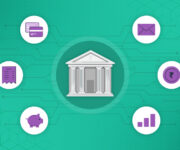Mobile banking has become a popular way for consumers to perform banking tasks today—from depositing checks and transferring money between accounts to paying their bills and setting up automatic payments.
In fact, 82% of bank clients believe mobile applications enhance their financial lives. So what is the effect of this mobile banking boom on the digital economy? In this article, we understand the importance of mobile banking in the digital economy.
The Digital Progression
Transformations to the digital economy follow three distinct phases:
- First, companies harness technology to create products and services.
- The next step is distribution, taking advantage of online transactions, and easy access to information.
- Finally, the transformation culminates in the fundamental disruption of the industry, along with a radical transformation of existing business models and user experience.
The same is true for mobile banking, which has moved from being a novelty to becoming a necessity for consumers, especially after a shocking surge during the pandemic.
For instance, a survey, conducted by S&P Global Market Intelligence last year, revealed that about 52% of respondents had visited branches fewer times since the pandemic began. Over 65% of these respondents also used their mobile apps more frequently.
You see, there’s no denying the appeal of mobile banking: Most consumers carry their smartphones virtually everywhere, so an app can help them manage their finances far more quicker than legacy methods.
Banks can help customers solve their most pressing financial issues in the coming years through customised mobile banking experiences.
According to Statista, India’s digital payments market will reach one trillion U.S. dollars by 2023. However, please note that digital payments are just one aspect of mobile banking…
Banks are already testing multiple product features such as digital invoice and bill management, customisable dashboards, 3rd party partnership offers, impact tracking for donations, and many more in response to the following customer needs.
Also read: How Developing Nations Are Driving the Mobile Banking Revolution
How Mobile Banking is Embalming the Financial Pain Points in India
Change comes with risks; however, innovation often creates uncertainty in an economy dependent on the financial system.
Over the past decade, banks have made in-person purchases and services accessible online to offer convenience and cost-efficiency. As a result, customers can interact with the bank just like in person.
Despite that, many banks have invested little in improving customer experience. Some of the pain points of customers include:
Poor self-administration options: It is difficult for customers to update or manage their personal information without calling or visiting a branch, and the tools are limited for delegating permissions.
Disparate experiences across channels: Often, financial institutions fail to connect employee platforms with user self-service.
Lack of notifications: Customers prefer to be notified when they make a purchase or when they are eligible for an offer.
Sync issues: Customers can incur overdraft fees if transactions are not updated in real-time.
Unorganised personal finances: It is hard to visualise savings and track financial goals in many banking apps.
Lack of guidance in generic insights. Banks sometimes fail to cater their services and solutions to individual needs.
This is where mobile banking comes into the picture, improving the banking experience of consumers through customised services, easy tracking and notifications, and indirect benefits like increasing family savings rates and minimising the effects of financial crises.
Also read: Top 4 Mobile Banking Risks and How to Mitigate Them
Mobile Banking in 2022: How is it Changing the Game?
Mobile-only neo-banks have become more popular over the last decade.
Since neo-banks do not have to maintain branches or legacy systems, their focus is on providing a superior digital experience for their demanding customers.
Here are some benefits of mobile banking:
- Accessibility: Mobile banking makes it convenient to access your account anywhere – except for planned maintenance updates and unexpected outages. You can access your account whenever you like.
- Money-saving tips: Managing your money has never been easier with the help of mobile banking apps. You can also use mobile banking apps to optimise your finances with spending alerts.
- Enhancing security: Banks safeguard your assets, including transactions performed via mobile apps. A mobile app from a financial institution typically offers additional security features, such as multi-factor authentication, which calls for at least two types of authentications to safeguard your account.
- Easy payment of bills: Users can set up automatic utility bill payments with digital banking, such as electricity, gas, and phone, with ease. It is no longer necessary for the customer to remember the due dates. In addition, customers can be notified of upcoming payments or outstanding dues.
- Service availability to remote areas: The extension of digital banking to remote areas would appear to be a step towards holistic development. In rural areas, where smartphones are easily accessible and internet access is generally affordable, (digital) banking is becoming more accessible to the rural population.
As a result, mobile banking and mobile payment systems provide significant advantages in cost, flexibility, safety, and immediacy.
Previously unbanked people can now avail of mobile banking services such as long-distance remittances and micro-payments, thanks to prepaid cards and inexpensive handsets.
With mobile banking, financial institutions, which had trouble providing profitable services through traditional channels, can expand their customer base across various economic strata, further enhancing the digital economy.
Bottom-Line
Mobile banking capabilities are designed to help customers in various ways, some of which could fundamentally impact the digital economy.
For example, consumers now have greater control over their finances thanks to 24/7 access to accounts and the ability to transact online without visiting their local bank.
Through frictionless digital experiences, banks can redefine their retail banking offerings in 2022 and beyond. However, banks must-see digital channels as more than simple tools for cutting costs to achieve this.
In the future, they can be more mindful of reframing the digital experience to deliver more valuable and personalised customer interactions through mobile and online banking.
Finezza‘s loan cycle management solutions help financial institutions stay competitive by optimising their lending processes. Contact us today to know more!




Leave a Reply